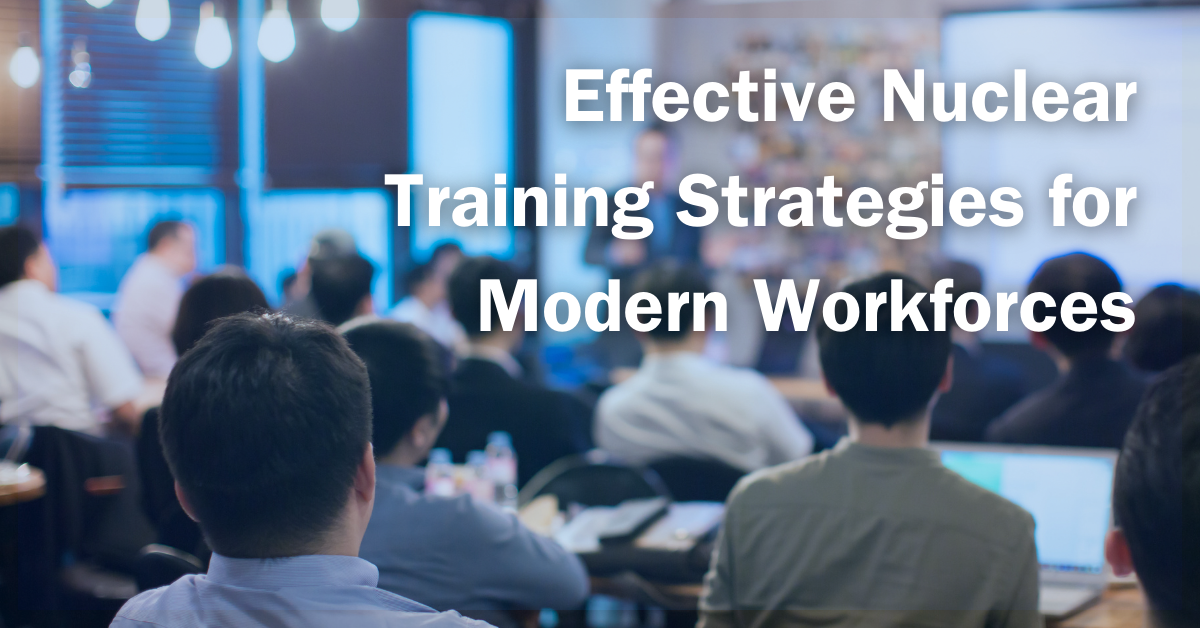Effective Nuclear Training Strategies for Modern Workforces
In the ever-evolving landscape of nuclear technology, it’s crucial to adopt effective nuclear training strategies. These approaches must comply with regulatory standards such as the Systematic Approach to Training (SAT), National Academy for Nuclear Training (ACAD), and the applicable sections of Title 10 of the Code of Federal Regulations (10 CFR). The design approach should also embrace the unique requirements of next-generation nuclear systems, such as Small Modular Reactors (SMR) and Advanced Modular Reactors (AMR).
Here are some best practices for designing effective nuclear training strategies:
Identify the target population and analyze the training program needs:
- Each discipline of the nuclear power plant workforce is different, not only the performance of each job but also the prerequisites of what individuals should possess at an entry level. Identifying these key attributes of each discipline job is essential.
- Recognize the general knowledges that all trainees require as part of the on-boarding process to provide an understanding of the training program and the use of technology.
- Perform a thorough Job Task Analysis to identify the specific skills and knowledge required for each position. The discipline ACAD provides generic guidance of the requisite skills and knowledge however, there may be site-specific information that needs to be included.
- Assess regulatory requirements and ensure the training program addresses compliance with 10 CFR standards.
Design the Curriculum:
- Clearly define the cognitive and performance objectives for each task with a clear line of sight of the evaluation methods to gauge the mastery of these objectives.
- Incorporate a mix of training methods, including classroom instruction, web-based instruction, synchronous and asynchronous learning, hands-on laboratory exercises, simulations, virtual reality, and performance training and evaluation.
- Leverage technology for e-learning modules and virtual simulations to enhance engagement and knowledge retention.
Qualified Instructors:
- Ensure that instructors are qualified, experienced, and possess the necessary expertise in the subject matter to design, develop, implement, and maintain the training program.
- Provide ongoing training for instructors to keep them proficient on innovations and technology, industry standards, and best practices.
Assessment and Evaluation:
- Implement regular assessments to gauge participants’ understanding and proficiency.
- Conduct periodic evaluations to assess the effectiveness of the training program and make necessary adjustments.
Continuous Improvement:
- Establish a feedback process for participants to provide input on the training program.
- Continuously review and update the training curriculum to incorporate lessons learned, industry advancements, and regulatory changes.
Skills and Knowledge Maintenance:
- Design a continuing training program based on an analysis of training needs for refreshing knowledge and job-related skills, for personnel performance improvements, for new or modified performance requirements and standards, and for regulatory requirements.
- Periodically assess the knowledge and skills refresher training to determine if any adjustments are needed to maintain the proficiency of the workforce.
Documentation and Records:
- Maintain comprehensive records of training activities, including attendance, individual progress, and assessments.
- Ensure that documentation complies with regulatory requirements.
Adherence to the SAT process, ACAD guidance, and 10 CFR regulatory requirements are the minimum baseline of a training program in the nuclear industry. The future of nuclear training is not static, but quite dynamic with the advent of new plant designs of SMRs and AMRs. The skills and knowledge required to operate and maintain these plants will be very different, as will the workforce. The traditional methods of training and instruction have evolved from rogue memorization to the effective use of innovation and technology to improve cognition and retention, while being efficient with resources to achieve the desired outcome of a highly trained and proficient workforce. This method of nuclear training is not just the future, it is now. The Nuclear Excellence Academy (NEXA™) are the leaders in centralized, turn-key nuclear training, now and in the future.



